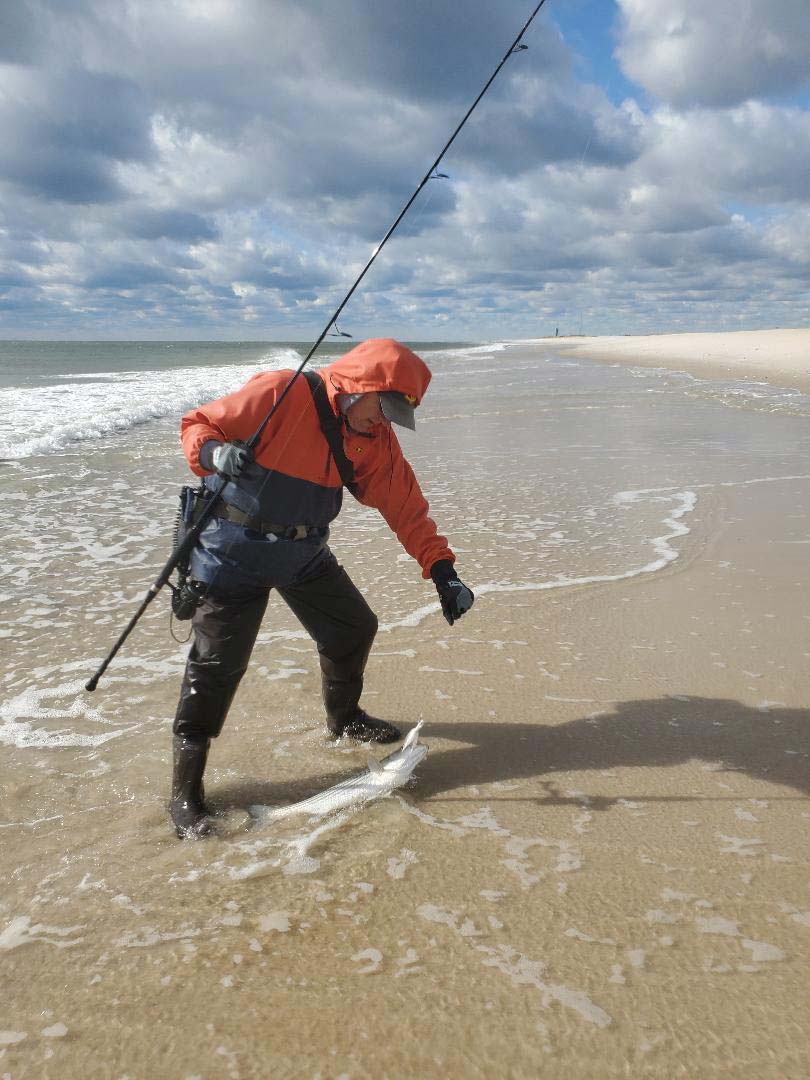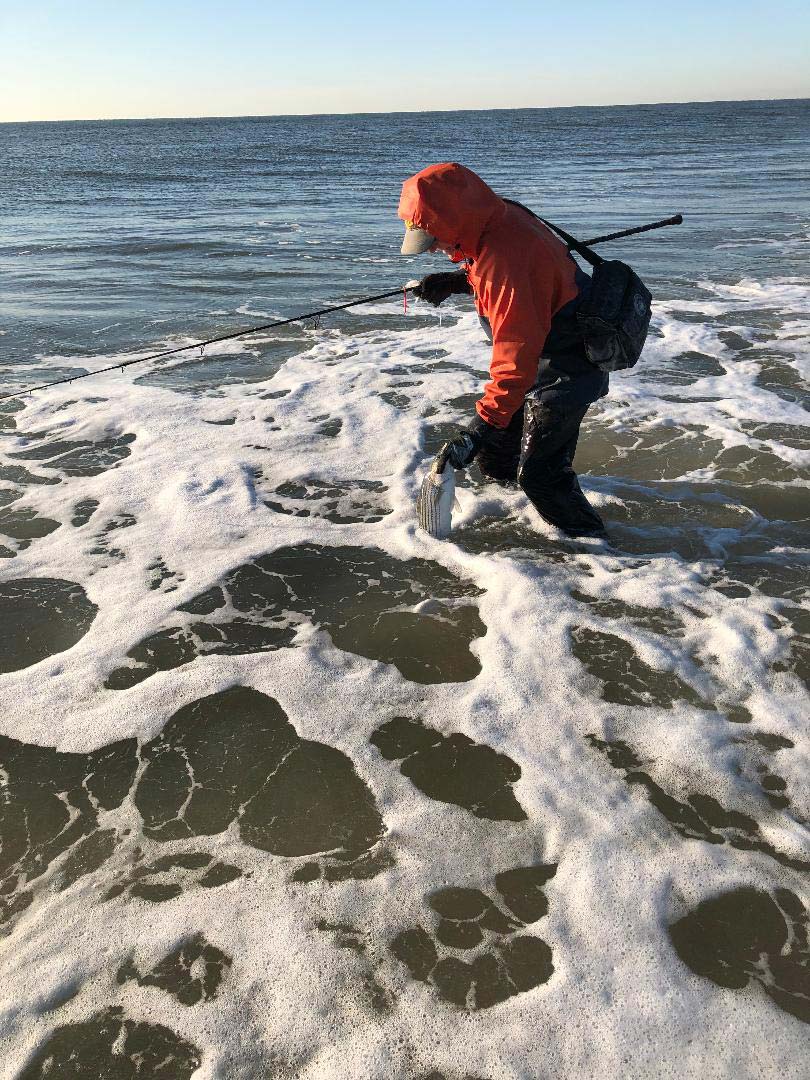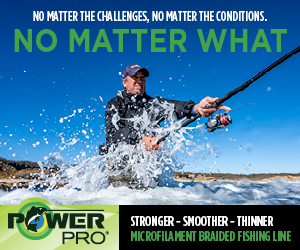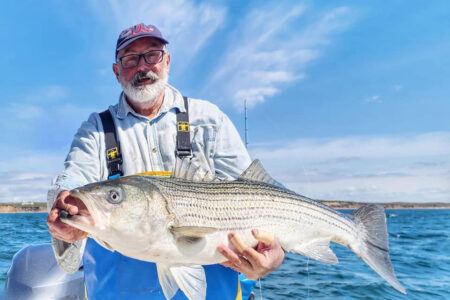Clearly, recent decades have witnessed trends in both surf fishing for blues and striped bass, and to remain connected to the fish during these changes, anglers need to adapt on the run.
In the last 10 years, most autumns have produced runs of stripers on the south shore. In 2010 there was a good showing of 18- to 24-inch stripers with a few giant blues mixed in. In 2013 there was a fantastic three week run of large stripers with no blues; at least that I caught or saw. In 2017 an angler could catch 60 to 80 stripers a day but they were all 14 to 20 inches and no bluefish. Finally, in 2019 there were good numbers of mostly 20- to 28-inch stripers and no blues.
Do we see a trend? Do these fall runs suggest that striped bass stocks are in very good shape? Do these runs suggest a precipitous decline in bluefish? The answers are, yes, no, and yes.
Trends:
 Clearly, recent decades have witnessed trends in both surf fishing for blues and striped bass, and to remain connected to the fish during these changes, anglers need to adapt on the run. As bait and fish populations wax and wane, anglers may find that last month’s or last year’s techniques and favored lures are either more or less effective. To understand this, let’s go back in time and remind ourselves what surf fishing was like prior to 1980. Of course, shortly after 1980, the striper population took a steep nose dive. The decline brought about a striper harvest moratorium that set the stage for a recovery of the species and fantastic striper fishing in the 1990s.
Clearly, recent decades have witnessed trends in both surf fishing for blues and striped bass, and to remain connected to the fish during these changes, anglers need to adapt on the run. As bait and fish populations wax and wane, anglers may find that last month’s or last year’s techniques and favored lures are either more or less effective. To understand this, let’s go back in time and remind ourselves what surf fishing was like prior to 1980. Of course, shortly after 1980, the striper population took a steep nose dive. The decline brought about a striper harvest moratorium that set the stage for a recovery of the species and fantastic striper fishing in the 1990s.
In those days, a surf angler’s fall run began in early to mid-September after the first nor’easter or sharp cold front that initiated the mullet run. Within weeks the mullet run was exhausted and sometimes there would be a short lull in the action before peanut bunker, anchovies, or some other small bait moved west along the south shore. The second phase of the run lasted into October and was often followed by a second short lull before sand eels moved inshore. These long multi-phased fall runs were possible not only because of sequential abundant bait, but because the coastal migration was very large and there were many large schools of stripers and blues stretched out along the coast, including resident New York stripers. It was resident stripers that responded to the mullet and then moved west with them. Unfortunately, we don’t have a lot of south shore resident stripers these days due to a variety of reasons.
The later stages of the multi-phase fall runs were primarily a result of many large, or mega, schools, of Chesapeake stripers along the coast, and competition would cause some of them to leave Massachusetts early when small baits began leaving the estuaries. Finally, at the end of the run were the last few schools that lingered off New England before moving south in November. These stripers arrived in our waters just in time to feast on sand eels. By late November and early December the action consisted mostly of Hudson fish that didn’t have far to go to reach their winter hang outs.
Stocks:
Today, many scientists and managers believe that striped bass stocks have declined significantly so that there may be only one mega school of Chesapeake stripers (largest stock) and therefore, we get fall striper runs with only one phase. Furthermore, a recent lack of blues in the fall accentuates the lulls in striper fishing. Sadly, bluefish stocks have collapsed due to many years of fair to poor recruitment, overharvesting, and a pattern of denial from the Mid-Atlantic regional Fisheries Management Council, but our catch data supports the reality. Although we began warning managers about the decline as early as the late 1980s, it took a depressing recent stock assessment to produce a management adjustment of three blues per day per independent angler, and five for anglers on boats-for-hire.
New Reality:
A hallmark of good surf fishermen is an ability to adapt to changes in bait, fish abundance, beach structure, and regulations. In the present reality, we must adjust to few weakfish and bluefish, and one mega school of stripers. Sadly, an historical reality is absent for many newcomers who believe that current surf fishing is as good today as it ever has been. It’s also true that decades ago more bass over ten pounds were caught throughout the long fall run. In those decades the only pure small fish runs occurred after Thanksgiving. This last push of tiny fish was the signal to surf rats that the season was over. Many old timers grouse about the lack of big fish and sometimes stop fishing because of it. However, let me suggest that since fishing is about fun, why not adapt in order to have fun under the present conditions, rather than stubbornly hold onto the past. While making the best of the “now”, we can hope for a brighter future and fight for better management.
Adjusting Our Attitudes:
Many surf anglers have decided not to scoff at the present reality and are attempting to adjust attitudes first and tackle second. Attitude adjustment begins with a willingness to enjoy fishing. Accepting the present reality rather insisting on a past standard that no longer exists. The old reality may return someday or, it may not, but in the meantime let’s have fun.
Once we get our brains adjusted to the real world, we can reexamine our tackle. In the post WWII era, surf tackle was very different. Rods, reels, and lines were not as user friendly or dependable. When monofilament line found its way into the fishery and replaced linen line, it seemed to be a miracle. Then spinning reels, then better spinning reels, and fiberglass rods. Wow! What a difference those advances made.
We used mostly 11-foot rods, and coffee grinder (because they were noisy) spinning reels, and 15-pound test mono with a long shocker of 25-pound test. That tackle caught fish, but there was a lot of maintenance on reels. Thankfully, their designs were simple so we could easily repair them. I used a Penn 706Z for decades and carried a bin full of parts so I could make repairs on the tail gate of my truck in minutes and get back in the action. No one could possibly dream of using a 9-foot rod and small reel at Montauk or in the south shore surf, and when we tried to do it on the north shore in quiet water the results were also disappointing.
We employed honey colored glass rods and the reel to use was the Penn 710. The honey fiberglass was so limber that combined with stretchy monofilament line it was difficult to sink a hook. Catching a really big fish was more like taming a runaway bull than catching a fish. The Penn reel was a great reel in its day, but unless you lined up the bail just so, it would flop over on a cast and your lure would begin a joy-ride to Connecticut.
Today’s Tackle:
Today’s tackle is so advanced that it makes many things possible that were never possible before. For example, in recent years I’ve been using a 7-foot graphite rod paired to a VS 150, and 20-pound test braid on the north shore. This combination is so responsive, sensitive, and powerful that it has allowed me to catch and enjoy large and smaller fish alike. I don’t use it on the south shore for several reasons: a need for distance, winds in your face, the frequent need for large lures, and big waves. The demands of these factors require the use of a 9-foot graphite rod, VS 200, and 20-pound test braid. This 9-foot outfit can do what my old 11-foot gear did in the 1970s, is much lighter, and more sensitive. There are precious few occasions when I wish I had an 11-foot setup.

The advantage of this lighter tackle is obvious when one considers the runs of smaller fish that have been available in the last ten years. Even 16-inch stripers put a bend in my 9-footer, whereas the fight would have been almost non-existent on a true south shore 11-foot combo. But my 9-foot combo has the power to tame larger fish without stress. Last fall I caught a 26-pound striper on that outfit and never once felt out of control. By the way, the same outfit served me just as well in the fall of 2013 when almost all the fish were large.
I’ve made other adjustments to the smaller fish trend. I rarely use anything but single hook lures so that I do less damage to the fish I release, it’s safer for me, and I can remove fish quickly and catch another one. Bucktails, feathered metal lures, metal lures with tubes, and lead-heads with soft plastic are my main stays on both shores, but the ones I use on the south shore are typically heavier.
Although my 9-footer can cast almost as far as my old 11-foot outfit, I’ve discovered that it’s often a waste of time to lean into a cast in an attempt to reach the outer bar. There seem to be as many stripers close to the shoreline as there are out near the bar. Sure, there are still many anglers with 11-foot gear and I watched them lean into casts with Ava 27 and 37 diamond jigs, get near the bar, hook up and drag little fish to the beach without much of a fight. At the end of the day, they haven’t gotten the fights out of the stripers that I did and their shoulders and necks were sore. Sometimes adjustments are premature, but sometimes they are timely and better.
Plug Bag:
Since I’m using lighter tackle and tend to work fish that are close to the beach and at my feet, I’ve been carrying lighter lures, too. Lighter rods and reels and lighter lures mean my body isn’t nearly as abused as it was when I wielded the 11-footer, and since my bag is lighter there is much less weight on my neck and shoulders.
About 90% of the time lures weighing between 1 and 1-1/2 ounces are effective. I do carry one heavy “tin” and one 2-ounce bucktail just in case, but rarely need to use them. This brings us back to an angler’s state of mind. If he/she believes that the best way to catch fall run stripers is with the big tackle, then that’s what the angler will use. If the angler doesn’t try new approaches, they will never understand the advantages of lighter gear, even when they watch other anglers catch lots of fish on lighter tackle. Perhaps they pray for an unlikely tuna fish to rumble through the trough and attack their lure, or maybe it’s just habit.
Whatever the mindset, my experience mentoring new surf anglers has taught me that it is difficult to change a mindset regardless of how much common sense and visual evidence is at hand. However, that doesn’t change the facts. Today’s technologies have made light rods and reels just as effective as the bigger gear of yesteryear, and since fall runs have been, and are likely to continue to be, dominated by smaller fish, maybe it’s time for a change. I don’t want to plane small fish to the sand, rather I want to experience full contact with Nature and let those fish show off a little. Now, you are reading an article written by a guy that, as a boy, fished for big killifish with a small safety pin and mussels when no one could take him fishing. This guy enjoys big weaks, blues, and stripers, but also bluegills, yellow perch, and snappers. I just love fishing, the connection to nature, the interplay with a living creature that I don’t have to kill but must fool: it’s very satisfying.
Adaptation police don’t exist, and there are many ways to “skin a cat”, but the smart play involves giving a little thought to how you might get more enjoyment out of our south shore fall runs of fish, don’t you think? After all, isn’t fun the object of the game?



